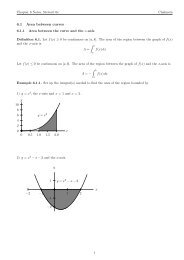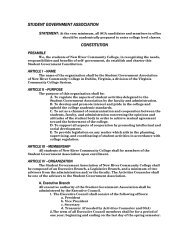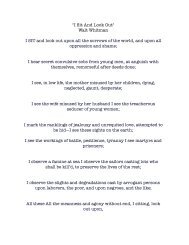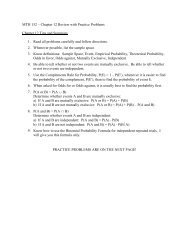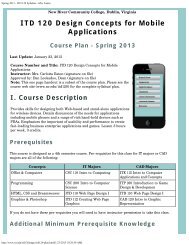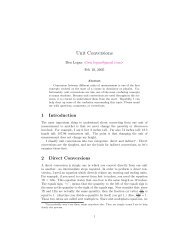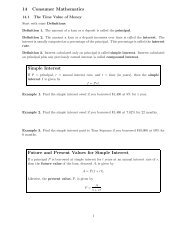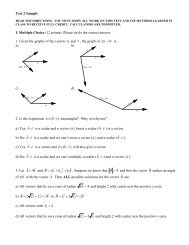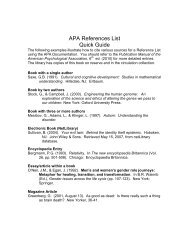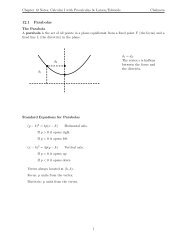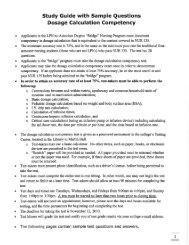CAD 242 UCAV - Concept Design Project
CAD 242 UCAV - Concept Design Project
CAD 242 UCAV - Concept Design Project
Create successful ePaper yourself
Turn your PDF publications into a flip-book with our unique Google optimized e-Paper software.
Animations of Main Assemblies (Produced in Inventor Studio or 3ds)o One with parts with no materialso One with parts with materials Animations of Sub Assemblies where applicable (no lines)o One with parts no materialso One with parts with materials 6 C-size sheets with one isometric view of UAV with UAV Nameo Each sheet should have a different Isometric viewo There should be 3 different color schemes 2, 2 and 2DIGITAL -o Min of 3 High Resolution .jpg images of each part of the aircraft.o Images must include USAF Text / Decals on appropriate parts of aircraftFINAL PROJECT printed out on C-size (set up all TB's for C size )7
WEIGHTS:Empty 43,340 lb (19,660 kg)Normal Takeoff 60,000 lb (27,215 kg)Max Takeoff 83,500 lb (37,875 kg)Fuel Capacity internal: 20,650 lb (9,365 kg)external: 15,865 lb (7,195 kg) in four 600 gal (2,270 L) tanksMax Payload 3,915 lb (1,775 kg) [internal]approximately 19,000 lb (8,620 kg) [external]PROPULSION:Powerplant two Pratt & Whitney F119-100 afterburning turbofansThrust 70,000 lb (310 kN)PERFORMANCE:Max Level Speed at altitude: 1,355 mph (2,180 km/h) at 30,000 ft (9,150 m), Mach 2 [afterburner]1,070 mph (1,725 km/h) at 30,000 ft (9,150 m), Mach 1.6 [supercruise]at sea level: 920 mph (1,480 km/h), Mach 1.2Initial Climb Rate unknownService Ceiling 50,000 ft (15,240 m)Range typical: 2,000 nm (3,700 km)ferry: unknownEndurance unknowng-Limits +9.0 / -3.0ARMAMENT:Gun one 20-mm M61A2 Vulcan cannon (480 rds)Stations four internal weapons bays and four external hardpointsAir-to-Air Missile AIM-9M Sidewinder, AIM-120A/C AMRAAMAIM-9X Sidewinder plannedAir-to-Surface Missile noneBomb GBU-32 JDAMGBU-39 Small Diameter Bomb plannedOther unknown9
MQ-9 REAPER10
Lockheed VARIOUS VTOLMorphing Z Wing - Lockheed12
The air vehicles (other than Hypersonic) must have minimum capabilities of or have minimumspecifications of: Performing armed or unarmed reconnaissance Housing and internal airborne surveillance system Executing single target acquisition Having a Med – High resolution FLIR thermal imaging camerao Multiple fields of view (19mm – 560mm) Providing high resolution near real time imagery of large geographical areas Able of being controlled by a Mission Control Ground Station Data up – and – down-links via the Ku satellite and UHF satellite systems Implementing and executing a threat identification avoidance system Incorporating reflecting telescopic imagery or similar technology to provide commonoptics for infrared and electro-optical sensors.o May be internal or gimbal mounted or combination. Utilizing a synthetic aperture radar and Ground Moving Target Indicator or similartechnology Carrying internal Payloadso Exchangeable & Deployable Weapon systemso Exchangeable and upgradable sensors & equipment Carrying an external Payload of between 400 and 2,000 lbs. Ceiling: between 18 and 40,000 feet Conventional Launch and Recovery – 2,000 feet Endurance of 20 – 40 hours Range between 150 and 500 Nautical Miles Have a Unit Cost of $10 – $50 million All weather surveillance, 1 foot resolution13
Traditional wing construction and terminology.Traditional wing construction and terminology.16
Rolls-Royce lift fan installed just behind the cockpit. This is driven by a shaft from the main engine, using aclutch to engage and disengage it. The two-stage, contra-rotating fan compresses air, which is then allowed toexpand, producing thrust: it takes about 15 seconds forthe fan to spool to full speed.5 There is no combustion so the jet flow is cooler. Thelift-fan thrust is balanced by that from the F-135(derived from the F119) engine directed downwardthrough a three-bearing vectoring nozzle and roll postsinstalled in the wing. The nozzle and roll posts are alsofrom Rolls-Royce. Varying the thrust split between thelift fan and engine controls pitch.Pros: The fan and engine produce more thrust than theengine alone, a technique used by the Harrier andBoeing X-32B demonstrator.Cons: The shaft spinning at high speed and the need forthe clutch to engage and disengage the lift fan represent added complexity. The lift fan and nozzles are a deadweight during flight and they take up vital fuselage space which will be used for extra internal fuel tanks in theCV and CTOL variants, giving them a significantly longer range than the STOVL variant.a*717
4Links from Stanford University Air Craft <strong>Design</strong> Web Site.0. Preface0.1 Instructions0.2 General References1. Introduction1.1 Historical Notes1.1.1 Aerodynamics History1.1.2 Boeing History1.1.3 Airbus History1.1.4 Invention of the Airplane1.2 Aircraft Origins1.2.1 New Aircraft Development1.2.2 The Airline Industry1.3 Future Aircraft1.4 References2. The <strong>Design</strong> Process2.1 Market Determination2.2 <strong>Design</strong> Requirements and Objectives2.3 <strong>Design</strong> Requirements2.4 <strong>Design</strong> Optimization2.5 Computational Methods3. Fuselage Layout3.1 Cross Section <strong>Design</strong>3.1.1 Cross Section3.2 Fuselage Shape3.2.1 Fuselage Layout3.3 FARs Related to Fuselage <strong>Design</strong>3.3.1 Seating-Related Items3.3.2 Emergency Egress3.3.3 Emergency Demonstration3.4 Fuselage <strong>Design</strong> for SSTs4. Drag4.1 Parasite Drag4.1.1 Skin Friction Coefficient4.1.2 Form Factor4.1.3 Wetted Area4.1.4 Control Surface Gap Drag4.1.5 Nacelle Base Drag4.1.6 Fuselage Upsweep Drag4.1.7 Miscellaneous Drag Items4.2 Induced Drag4.3 Compressibility Drag4.3.1 Introduction4.3.2 Predicting Mdiv4.3.3 3D Effects and Sweep4.3.4 Computing CDc4.3.4.1 Computational Example4.4 Supersonic Drag4.4.1 Volume Wave Drag18
4.4.2 Lift-Dependent Wave Drag4.4.3 Program for Wave Drag Calculation4.5 Wing-Body Drag Polar5. Airfoils5.1 History and Development5.2 Airfoil Geometry5.3 Pressure Distributions5.4 Cp and Performance5.5 Relating Geometry and Cp5.5.1 Cp and Curvature5.5.2 Interactive Calculations5.6 Airfoil <strong>Design</strong>5.7 Typical <strong>Design</strong> Problems5.7.1 Thick Sections5.7.2 High Lift Sections5.7.3 Laminar Sections5.7.4 Transonic Sections5.7.5 Low Reynolds Number Sections5.7.6 Low Cm Sections5.7.7 Multiple <strong>Design</strong> Points5.8 Airfoil <strong>Design</strong> Program6. Wing <strong>Design</strong>6.1 Wing Geometry6.1.1 Wing Geometry Drawing6.2 Wing <strong>Design</strong> Parameters6.3 Lift Distributions6.3.1 About Wing Lift Distributions6.3.2 Geometry and Lift Distributions6.3.3 Lift Distributions and Performance6.4 Wing <strong>Design</strong> in More Detail6.5 Nonplanar Wings and Winglets6.6 Wing Layout Issues6.7 Wing Analysis Program6.8 Supersonic Wings7. High-Lift Systems7.1 Introduction7.2 General Approach7.4 Estimating CLmax7.5 CLmax for SSTs7.6 Wing-Body CLmax Calculation8. Stability and Control8.1 Introduction8.2 Static Longitudinal Stability8.2.1 Stability and Trim Calculation8.3 Dynamic Stability8.4 Longitudinal Control8.5 Lateral Control8.6 Tail <strong>Design</strong> and Sizing8.7 FARs related to Stability8.8 FARs related to Control19
9. Propulsion9.1 Basic <strong>Concept</strong>s9.2 Installation9.2.1 Engine Placement9.2.2 Nacelle <strong>Design</strong>9.2.3 Supersonic Considerations9.3 Performance & Engine Data9.3.1 Thrust vs. Speed and Altitude9.3.2 SFC and Efficiency9.3.3 Large Turbofan Data9.3.4 Small Turbofans Data9.3.5 Engines for SST's9.4 Engine Model10. Structure and Weights10.1 Structural Loads10.1.1 <strong>Design</strong> Airspeeds and Placards10.1.2 Placard Calculation10.1.3 V-n Diagrams10.1.4 V-n Diagram Calculation10.1.5 FAR Structures Requirements10.1.6 FAR Gust Rules10.2 Structural <strong>Design</strong>10.3 Weight Estimation10.3.1 Component Weights10.3.2 Sample Weight Statements10.3.3 Total Weights10.4 Balance10.5 Weight Calculation11. Performance Estimation11.1 Take-Off Field Length11.1.1 Take-Off Calculation11.2 Landing Field Length1.2.1 Landing Calculation11.3 Climb Performance11.3.1 Climb Calculation11.4 Cruise Performance and Range11.4.1 Range Calculation11.5 FARs Related to Aircraft Performance11.5.1 FARs Related to Take-Off11.5.2 FARs Related to Climb11.5.3 FARs Related to Landing12.Environmental Impact12.1Noise12.2 Noise Calculation12.3 Emissions12.4 Emissions Calculation12.5 FAA Part 3613. Cost13.1 DOC and IOC13.2 ATA Method13.3 Cost Calculation20
13.4 Airplane prices13.5 Consumer Price Index14. Optimization and Trade Studies14.1 Performance Trade Studies14.2 About the Variables...14.3 Notes on Optimization14.4 Optimization Program14.5 Airplane Top View14.6 Airplane 3-D View and Summary15. Appendices15.1 Standard Atmosphere15.2 Unit Converter15.3 Summary of <strong>Project</strong> Inputs15.4 Summary of Results15.5 Common Acronyms and Abbreviations15.6 Unit Selectionhttp://www.aoe.vt.edu/~mason/Mason_f/ConfigAero.htmlhttp://adg.stanford.edu/aa241/Aircraft<strong>Design</strong>.htmlhttp://www.desktopaero.com/appliedaero/preface/welcome.htmlhttp://ntrs.nasa.gov/search.jsphttp://www.engapplets.vt.edu/This one is a large database of airfoil coordinateshttp://www.ae.uiuc.edu/m-selig/ads/coord_database.htmlUAV <strong>Concept</strong> <strong>Design</strong> <strong>Project</strong> – Quote from Thesis21
“As the U.S. military is deeply engaged in the Global War on Terrorism, it must face the challenges ofjuggling transformation and combat operations around the globe. Special care must be given to satisfy therequirements of the combatant commander during a time of war and the long term requirement to maintain acredible military force capable of executing a major theater war in support of the U.S. National SecurityStrategy. The forces are stretched thin and equipment is starting to wear out. The nation’s combat aircraftare older than they’ve even been in the past and new aircraft are not being developed and procured fastenough to replace the aging fleet. If current operations remain at their current levels, the nation could face anairpower capability shortfall if a scenario developed that required a major air operation in a combatantcommander’s overall campaign. The development and use of unmanned aerial vehicles must be carefullyBy: Major Daren Sorenson, USAFconsidered.”“The long war against terrorist networks extends far beyond the borders of Iraq and Afghanistan andincludes many operations characterized by irregular warfare – operations in which the enemy is not a regularmilitary force of a nation state. Long-duration, complex operations involving the U.S. military, othergovernment agencies and international partners will be waged simultaneously in multiple countries aroundthe world, relying on a combination of direct and indirect approaches. Above all, they will require persistentsurveillance and vastly better intelligence to locate enemy capabilities and personnel. A key capability listedin the QDR for defeating terrorist networks is “Persistent surveillance to find and precisely target enemyBy: Major Daren Sorenson, USAFcapabilities in denied areas.”One of the greatest challenges in the Global War on Terrorism is the ability to locate and then respondquickly to intelligence gathered on enemy positions or combatant activities. The UAV has proven innumerous instances to not only be able to provide real time data but also to engage the enemyinstantaneously.This project will incorporate numerous activities that will not only provide each member of the team theopportunity to showcase their talents, but will also help:Assignment No. 1- Read UAV Thesis paper- Write a one page, double spaced response- Paper is due at the beginning of class on the 2 nd Tuesday of class. We’ll do a class discussion onthe original thesis pertaining to UAV History and UAV’s importance in the context of today’sbattlefield.Physics Symbols and Tables22
abcdefghijklmnpqrstuvwxzAaccelerationimpact parameterthe speed of sound; the speed of light in vacuumdistanceeccentricity; Naperian logarithm basefrictional dragacceleration due to gravity; gravitational field strength; metric tensorPlanck's constantimaginary unit; Cartesian x-axis basis unit vectorimpulse; Cartesian y-axis basis unit vectorBoltzmann constant; spring constant; Cartesian z-axis basis unit vectorlength; angular momentummassnumber; number density; refraction indexmomentum; pressuredeceleration parameter; chargedistance; positionarc lengthtime; dimensionless parameterfour-velocity; relativistic mass; energy densityspeed; velocityweightpositionredshift23
BCDEFGHIJKLMNPQRSTUVXYZalphaatomic massmagnetic flux density; binding energy; bulk moduluscapacitanceelectric displacementenergy; electric field strengthforce; vector fielduniversal constant of gravitation; Einstein tensormagnetic field strengthaction; intensity; moment of inertia; electric currentcurrent densitykinetic energyinductance; luminositymagnetization; momentnormal vector; atomic numberpower; pressure; polarizationheatresistance; radiancy; Ricci tensorPoynting vectortemperature; tangential vectorpotential energyvoltage; potentialhydrogen ratiohelium ratio; Young modulusmetals (not H, He) ratio; impedance; proton numberangular acceleration; fine structure constant24
etavelocity in terms of cgammaEinstein factordeltachangeepsilonelectric constant; small value, 0 < e
Psi - wavefunctionOmega - angular precession velocity; solid angleprefix symbol value expanded value English nameyotta Y 10 24 1 000 000 000 000 000 000 000 000 U.S. septillion; U.K. quadrillionzetta Z 10 21 1 000 000 000 000 000 000 000 U.S. sextillionexa E 10 18 1 000 000 000 000 000 000 U.S. quintillion; U.K. trillionpeta P 10 15 1 000 000 000 000 000 U.S. quadrilliontera T 10 12 1 000 000 000 000 U.S. trillion; U.K. billiongiga G 10 9 1 000 000 000 U.S. billionmega M 10 6 1 000 000 millionkilo k 10 3 1 000 thousandhecto h 10 2 100 hundreddeca da [footnote 1] 10 1 10 ten10 0 1 onedeci d 10 -1 0.1 tenthcenti c 10 -2 0.01 hundredthmilli m 10 -3 0.001 thousandthmicro u [footnote 2] 10 -6 0.000 001 millionthnano n 10 -9 0.000 000 001 U.S. billionthpico p 10 -12 0.000 000 000 001 U.S. trillionth; U.K. billionthfemto f 10 -15 0.000 000 000 000 001 U.S. quadrillionthatto a 10 -18 0.000 000 000 000 000 001U.S. quintillionth; U.K.trillionthzepto z 10 -21 0.000 000 000 000 000 000 001 U.S. sextillionthyocto y 10 -24 0.000 000 000 000 000 000 000 001U.S. septillionth; U.K.quadrilliontha, A acceleration (length / time 2 ), atomic mass (total number of protons and neutrons in an atom)A Amperes* (electric current = C / s), Angstroms* (length = 10 - 10 m), amplitude (length)b intercept of a linear graph, drag coefficient (mass / time)B magnetic field (force / current)speed of light (2.998 x 10 8 m / s), specific heat (energy / mass x temperature), concentration (numberc/ volume), speed of soundcal calories* (energy = 4.186 J)cc cubic centimeterc g group velocityc p phase velocity26
Celsius* (temperature), Coulombs* (electric charge), capacitance (charge / electric potential), heatCcapacity (energy / temperature), concentrationCal kilocalories* (energy)Ci Curie* (unit of radiation, equivalent to 3.7 x 10 10 decays / s)d distanceD diffusion constant (area / time)db decibels (relative intensity)e electron, charge of an electron (1.602 x 10 - 19 C)eV electron Volts* (energy = 1.602 x 10 - 19 J)E energy (force x length, mass x velocity 2 ), electric field (force / charge)f frequency (1 / time), focal lengthf, F force (mass x acceleration)F flow (volume / time), Farads* (capacitance = C / V), Fermi* (length = 10 - 15 m)g grams* (mass), acceleration due to gravity (9.81 m / s 2 ); sometimes centrifugal accelerationG Newton's constant (6.673 x 10 - 11 N m 2 / kg 2) , Gauss* (magnetic field =10 - 4 T), free energyh height, Planck's constant (angular momentum = 6.626 x 10 - 34 J s), latent heat (energy / mass)hr hours* (time = 3600 s)H enthalpy (energy)Hz Hertz (1 / s)I moment of inertia (mass x length 2 ), current (charge / time), intensity (power / area), image distanceJ Joules* (energy = N m), flux (number / area time)Boltzmann constant (1.381 x 10 - 23 J / K), spring constant (force / length), thermal conductivityk(power / length temperature), wave number (1 / length)(1 / length)K kinetic energy, Kelvin* (temperature = C + 273.15)length, liters* (volume = 1000 cc), orbital quantum number (dimensionless, denotes angularlmomentum), mean free path (length)lb pounds* (weight; 1 kg weighs 2.2 lb)L angular momentum (momentum x length, moment of inertia x angular velocity)mass, meters* (length), slope of a linear graph, magnetic moment (current x area), magnetic quantummnumber (dimensionless, denotes orientation of angular momentum)m e mass of electron (9.109 x 10 - 31 kg)m n mass of neutron (1.675 x 10 - 27 kg)m p mass of proton (1.673 x 10 - 27 kg)mi miles* (length = 1.61 km)min minutes* (time = 60 s)mmHg millimeters of mercury (pressure = 1333 dynes / cm 2 )M molecular weight (mass / mol), magnification (dimensionless)numbers of mols (dimensionless), number of loops (dimensionless), neutron, principle quantumnnumber (dimensionless, denotes energy level), index of refraction (dimensionless)27
N Newtons* (force = kg m / s 2 ), number of particles, neutron number (number of neutrons in an atom)N A Avogadro's number (dimensionless number of objects in a mol = 6.022 x 10 23 )O object distancep protonP momentum (mass x velocity), pressure (force / area), power (energy / time)Pa Pascals* (pressure = N / m 2 )q, Q chargeQ heat (energy)r radius (length), distance, rate (velocity)R resistance (potential / current), gas constant (8.31 J / mol K)Re Reynolds number (dimensionless)seconds*, sedimentation coefficient (time), spin quantum number (dimensionless), lens strength (1 /slength)S entropy (energy / temperature)t timeT Tesla* (magnetic field = N / A m), temperatureU potential energy (mechanical, elastic, electrical), internal energyv velocity (length / time), specific volume (volume / mass)V velocity, volume (length 3 ), electric potential (electric field x length), voltage, Volts* (N m / C)W Watts* (power = J / s), weight (force), work (energy)x, X horizontal positiony, Y vertical position or depth position in 3D problemsz, Z vertical position in 3D problems, atomic number (number of protons in an atom), valence alpha angular acceleration (radians / time 2 ), Helium nucleus (2 p + 2 n) beta electron delta finite change "d" instantaneous rate of change epsilon electrical permittivity ( 0 = 8.854 x 10 - 12 F / m), emissivity(dimensionless), efficiency (dimensionless) phi angle gamma electromagnetic radiation, photon eta viscosity (Poise = dyne x s / cm 2 = g / cm x s) kappa dielectric coefficient (dimensionless) lambda wavelength mu magnetic permeability ( 0 = 4 x 10 - 7 T m / A) nu frequency or rate of revolution (1 / time) theta angle, angular position rho density (mass / volume), resistivity (resistance x length) sigma Stefan-Boltzmann constant (5.67 x 10 - 8 W / m 2 K 4 )28
sigma summation tau torque (force x length, moment of inertia x angular acceleration), radioactive half-life omega angular velocity or angular frequency (radians / time) omega Ohms* (resistance = volt / ampere)Longitudinal Section Views – Top & Side & Front ViewClassical - Standard Top, Front and Side views29
Specifications - Predator RQ-1 / MQ-1 / MQ-9Reaper - Unmanned Aerial Vehicle (UAV), USAWingspanLengthWingspan (Predator B)Length (Predator B)Weight Fully LoadedWeight PayloadWeight (Predator B)48.7ft (14.84m)27ft (8.23m)66ft (20.1168m)36ft (10.9728m)DimensionsWeightsUp to 2,300lb (1,035kg)450lb (202.5kg)10,000lb (4,536kg)Internal Payload (Predator B) 800lb (363kg)External Payload (PredatorB)Predator A3,000lb (1,361kg)EnginesRotax 4-cylinder enginePredator B Honeywell TPE 331-10TAltitudeRangeCruise SpeedEnduranceConventional Launch andRecoveryAltitude (Predator B)Endurance (Predator B)Airspeed (Predator B)25,000ft (7,620m)400nmPerformanceOver 70kt (129km/h)Over 40 hoursApproximately 2,000ft (600m)50,000ft (15,240m)Over 30 hoursOver 220kt (407km/hr)CommunicationsTwo-Colour DLTV Television Variable zoom, 955mm spotterHigh-Resolution FLIRSynthetic Aperture RadarOptional PayloadsSix fields of view, 19mm to 560mmAll weather surveillance, 1ft resolutionLaser target designator and rangefinder, ECM/ESM, moving targetindicator, communications relay33
DatalinksRadio RelayData Distribution SystemVehiclesGround DataData DisseminationTrailerAir TransportabilityC-band LOS, UHF and Ku-band satellite datalinkUHF and VHF radioTrojan Spirit II or Global Broadcast System for disseminationTwo HMMWV transports5.5m dish for Ku-band ground data terminal2.4m dish for data disseminationGround Station30ft x 8ft x 8ft (9.14m x 2.44m x 2.44m)C-130 and C-141 transportableFeatured Suppliers34
EO/IR Sensors -Electro-Optical/Infra-Red36
EO/IR SensorsFirst and foremost, an unmanned aircraft system (UAS) is an unblinking eye in the skyWhile the technology in this Intelligence, Surveillance and Reconnaissance (ISR) platform isevolving rapidly, the mission still remains the same, providing the fullest possible understandingof the adversary to the commanding officer. The unmanned aerial vehicle (UAV) has the rangeand endurance to provide a bird's-eye view of the battlefield and is flexible enough for dynamicmission re-tasking. This allows timely receipt of information about the enemy, when and whereit is needed, without having to risk a manned aircraft.Large UAVs like the Predator and Global Hawk can access Class A airspace (above 18,000 ft).Their long endurance and virtually unlimited range makes them ideal platforms for surveillanceoperations. They are routinely controlled halfway around the world by pilot-rated US Air Force37
officers. Ku-band satellite links are used for these beyond line-of-sight (BLOS) operations.Operational altitudes range for the smaller tactical UAVs like the Scan Eagle are typically from2,000-5,000 feet but flights up to 8,000 feet (6,000 at night) are common. Line-of-sight (LOS)range is about 50-100 miles when the ground is flat, or even less when hilly or mountainous.Electro-Optical/ Infrared (EO/IR) cameras are carried on many UAVs and work best atacquiring good imagery when operating at low altitudes. This is due to several factorsincluding:• a smaller amount of atmospheric haze,• a smaller focal-length and• smaller stabilization requirementsWhat affect does fog or low cloud ceilings have on the usefulness of these payloads?Can IR cameras penetrate a fog bank?How does fog change UAS operations?Take-offs or Landings?What about winds?Icing conditions?Or heavy rain?To help you answer these questions and to help you make sense of the rapidly changing UASindustry, the Applied Technology Institute/ATIcourses.com of Riva, Md., is offering a newone-day course designed for engineers, aviation experts and project managers who wish toenhance their understanding in the growing field of UAS.The course provides the "big picture" for those who work outside of the discipline. Each topicaddresses real systems (Raven, Shadow, Predator, Global Hawk and others) and real-worldproblems and issues concerning the use and expansion of their applications.UAS Course is on June 9th in Beltsville, MD.38
Related ProductsMilestonesRaytheon's Multi-Spectral Targeting System Delivers High-Definition Image CapabilityRaytheon's Advanced Airborne Optical Sensor System Studied for Missile Defense ApplicationRaytheon Airborne Targeting System Achieves 1 Million Flight HoursRaytheon’s Multi-Spectral Targeting System (MTS) family of sensor solutions provides superiordetecting, ranging and tracking for military forces worldwide.Integrated on manned and unmanned aerial systems such as the C-130 fixed wing aircraft, the MH-60helicopter and the medium altitude long endurance Reaper drone, Raytheon’s MTS surpassed onemillion operational flight hours on 1,000 fielded systems in August 2010. MTS sensors have beenintegrated on more than 16 platforms representing all branches of the U.S. military and Department ofHomeland Security assets. Numerous MTS products are flying aboard special mission aircraft forNASA, special operations forces and coalition fleets around the world.A turreted or forward looking pod combining multiple sensors, the MTS equips aerial platforms with anelectro-optical (EO) and infrared (IR) full-motion video camera system that permits long-rangesurveillance and high-altitude acquisition, tracking and laser designation.Combat proven, the system supports both U.S. and global military missions for rotary-wing, UAV, andfixed-wing aircraft. As aircrews and warfighters face evolving threats, the MTS meets the constantlyincreasing demand for actionable information to help intelligence analysts, soldiers and commanders inthe field make crucial operating decisions.These systems offer a number of fully-integrated options to meet the growing needs of a diversemilitary, national and scientific clientele:Multiple wavelength sensorsTV cameras (near-IR and color)IlluminatorsEyesafe rangefindersImage mergingSpot trackersOther avionicsThe multiuse system offers surveillance, target acquisition, tracking, rangefinding, and laser designationfor the HELLFIRE missile and for all tri-service and NATO laser-guided munitions such as the PavewayLaser Guided Bomb. The Advanced Targeting Forward Looking Infrared (ATFLIR) pod is also used inconjuction with Paveways, JSOWs and HARMs.39
To ensure operational reliability, the MTS was designed to meet environmental testing extremes. Itsadvanced electronics and optical design allow for capability and performance enhancements throughadd-in circuitry.The MTS sensors carry the military designations of AAS-52, AAS-53, ASQ-228, DAS-1 and DAS-2.Dependable, flexible and easily supported, the MTS will continue to be the world’s most advancedintegrated EO/IR system.Raytheon’s Advanced Targeting Forward Looking Infrared pod delivers pinpoint accuracy andreliability for air-to-air and air-to-ground mission support.ATFLIR’s unmatched technical advantages enable aviators to perform their missions, in the harshestconditions, with maximum efficiency and security. Its plug-and-play performance allows for easyinstallation and seamless operation for enhanced interoperability with coalition forces.Raytheon’s Advanced Targeting FLIR assures mission success by integrating advanced EO and IRsensors with one of the most powerful lasers on the market. ATFLIR can locate and designate targetsday or night at ranges exceeding 40 nautical miles and altitudes surpassing 50,000 feet, outperformingcomparable targeting systems. As a powerful net-enabler, it can pass tracking and targeting informationto other nodes in the networked battlespace with the speed and precision.Now in full-rate production, fully integrated and flight tested on all F/A-18 models, ATFLIR providesaircrews with unparalleled performance:A substantial increase in target detection/recognition rangePinpoint accuracy and assessment from longer standoff rangesThe most advanced laser designation capabilitySuperior EO/IR imageryThe program's Operational Evaluation was one of the most successful in U.S. Naval aviation history.ATFLIR met or exceeded all of the Navy’s requirements, including effectiveness, survivability, reliability,and maintainability.The streamlined ATFLIR integrates laser tracking and infrared targeting functions on F/A-18 aircraft intoa single compact pod, freeing an air-to-air weapon station for other mission requirements. An IR markerhas been inserted and integrated on ATFLIR and will enter production soon.By incorporating the latest secure technology while allowing for future upgrade and enhancement,ATFLIR ensures continued aerial superiority. ATFLIR is positioned to serve as a critical node inFORCEnet, the fully networked battlespace of the future. Planned enhancements include:EO camera and laser spot tracker improvements40
Detection range increasesElectronics consolidationSensor fusionAutomatic target recognitionTruly technologically advanced, ATFLIR EO/IR sensor components utilize a single common optical pathand continuous automatic boresight alignment to ensure accurate target coverage and battle-testedsensor-to-shooter tactical mission support.Any and all material published in this document is done so for the sole express purpose of an educational project.Footnotes/Credits:*1 – New York Daily News, 2008*2 – www.theregister.co.uk, 2009*3 – graphics are public domain available on World Wide Web by Lockheed Martin, DARPA, USAF, General Atomics,flightglobal.com, Boeing, Northrop Grumman,*4 – Stanford University, AA241, Desktop Aeronautics, INC.*5 - Low Cost Constellations to Assist the Warfighter 01 AUG 2006 30 pagesAuthors: Stuart Eves; David Carter; David Beard; SURREY UNIV GUILDFORD (UNITED KINGDOM) SURREYSPACE CENTRE*6 – D.O.D. report 2006*7 – Rolls Royce Diagram of F135 engine/lift system for Lockheed Martin F-35 Lighting II41
CLASS SCHEDULE:10 minute project status review at the beginning of every Tuesday class.WEEK 1Tueseday Course and project introduction – <strong>Project</strong> Handout - Team will read this document prior to nextclassIntroduction to UAVs/Aerodynamics/o Introduction to Aerodynamic Principals and Terminology – PowerPointo Information covered in PowerPoints will be on a test in week 3Reading and Paper/Thesis Assignment - 1 page / double spaced typed - Due Thursday of 2nd Week.Start review of individual preliminary concept sketches (individual concept designs - what youthink you aircraft might look like) Overall dimensions(aircraft length, wing span - should have 2 - 3options each)o Once 1 st preliminary design has been settled on:• Will scan sketch and hand out to team• Each member will take it back rework sketch to review Tuesday-week 2 Each member will present their idea to the team stating whatimprovements/changes were made and whyThursday Team review of project handout – Questions about handout? Continue Aerodynamics / UAV History Work on secondary sketches fuselage shape / dimensions etc…(time permitting / finish at homebefore Tuesday)WEEK 2Tuesdayo <strong>Project</strong> Team Meetingo Present / Review secondary sketcheso Meet with Individuals to discuss:o Division of responsibilities• Fuselage / body of aircraft design• Wings• Structure• Propulsion System• Landing Gear• Weapons(all internal, no external pods) /Avionics/• Gimbal/radar• Assembly - all individual design aspects must mate properly with each other(fasteners,etc...)42
• Final Report• Final Presentation• Typed Report• PowerPoint• Final Animation• Animations (individual/team)• Each individual will have an assembly animation – Inventor/Showcase• Each individual will have an animation showing all moving parts as related to theirindividual design responsibilities.• Each individual will have a presentation animation in – Showcase• Fuselage / Structure Start 2D Auto<strong>CAD</strong> Sketches for overall designThursdayContinue working Engineering Sketches for individual . Each student will develop their ownidea of what the "team idea" is for the project. You will present your individual sketch to theclass. You will show Top/Front/Right side views along with overall dimensions. This will beaccompanied by a brief narrative of the advantages of your design.Turn in your weekly progress report to Team Leader.<strong>Project</strong> Progress CheckWEEK 3Tuesday10 Minute <strong>Project</strong> Team Meeting• This is where you tweak the design and start working in the details• Each team member will lay out their basic ideas in 2DThursdayExam on AerodynamicsTurn in 1 page report from week 1 assignmentWork on Auto<strong>CAD</strong> 2D SketchesTurn in weekly progress report to Team LeaderWEEK 4Tuesday10 Minute <strong>Project</strong> Team MeetingSubmit your 2D Auto<strong>CAD</strong> sketches to me.Start Inventor design43
ThursdayReview of Airframe <strong>Design</strong> - Structure/composites/alloys/carbon fiber etc...WEEK 4 PROJECT CHECKS Due end of classTurn in weekly progress report1 st research reportWEEK 5Tuesday10 Minute <strong>Project</strong> Team Meeting<strong>Project</strong> Review - Open class discussion / questions<strong>Project</strong> LabThursdayTurn in weekly report<strong>Project</strong> LabWEEK 6Tuesday10 Minute <strong>Project</strong> Team Meeting<strong>Project</strong> LabThursday<strong>Project</strong> Lab Turn in weekly reportWEEK 7Tuesday 10 Minute <strong>Project</strong> Team Meeting<strong>Project</strong> LabThursday<strong>Project</strong> LabPreliminary Individual Models of Fuselage, All wings(ailerons etc…) & Landing gear to beturned in at end of class – 3 rd PROJECT CHECK44
Turn in weekly reportWEEK 8SPRING BREAKWEEK 9Tuesday10 Minute <strong>Project</strong> Team Meetingteam members will develop individually a list of 8 - 10(total for the team) companies related totheir project that are involved in the research and development of the type(s) of technology thatthe aircraft represents to include D.O.D. contract companies, Universities, research companies,etc...• This TYPED & digital data (WORD) list will include:- Company Name- Contact Person- Phone Number- Mailing Address.- verification of all the above information via email or phone call is required.- The person's name and position that you spoke to by one of the above means isto be included with the list for each organization.<strong>Project</strong> LabThursday<strong>Project</strong> Lab Turn in weekly reportWEEK 10Tuesday10 Minute <strong>Project</strong> Team Meeting<strong>Project</strong> LabThursday<strong>Project</strong> Lab Turn in weekly reportWEEK 11Tuesday45
Thursday FINAL <strong>Project</strong> Team Meeting• During this meeting the team will develop its final game plan for project presentation• Will determine who will be in charge of sheet consolidation• Who will handle folder management for DVD• Will determine what renderings will be done of individual parts, assemblies as well asorientation of parts.• Will discuss what/how software will be used for notations and presentation- Showcase- Photoshop- PowerPoint<strong>Project</strong> Lab if time permits<strong>Project</strong> Lab Turn in weekly reportFinal Individual Models with Preliminary Dimensions and Progress on Assemblies and SubAssemblies to be turned in at end of class.Team selectee(s) should be in the process of working on animations (3DS Max & Premiere)Weeks 12, 13 and 14 will be spent on final assemblies/sub assemblies,corrections to individual parts, animation story boards, finalpresentations, PowerPoints, Renderings, Sheet Layouts, SheetNumbering, etc...WEEK 12PROJECT FINALIZATIONTuesday<strong>Project</strong> Lab• Final Skinning of the aircraft• Corrections to: Assemblies, Sub Assemblies & Final Dimensions/NotationsThursday<strong>Project</strong> LabFinal weekly report turned in46
WEEK 13PROJECT FINALIZATIONTuesday<strong>Project</strong> LabThursdayFull Assemblies and sub assemblies (Prelim Animation Story Boards/ Time Line Setup), balloonswith leaders, parts list.FINAL PROJECT CHECK. (for grading purposes)• 11x17 print outs of all sheets (B&W prints)• Sheet number/order-reordering of sheets• Dimension checksWEEK 14PROJECT FINALIZATIONTuesdayThursdayFINAL PRINT OUT for corrections.Start printing 8.5 x 11 renderingsWEEK 15TuesdayThursdayPROJECT CONSOLIDATIONTeam presentationsTeam project reports dueTeam project due * HARD COPY & DVDEXAM WEEK8am – until finished - Preparing of Industry PacketsColor Print Outs or Report Graphics47
Print Outs of Letters to IndustryBinding and Assembling of PacketsDVD Burning for Industry packets3Ds Max type software approach to an F-22 RaptorMike James 3D <strong>Project</strong> Hyperlink 3Ds Max type software approach to an F-22 Raptor48



